Organised by Grainne Hamilton at RSC Scotland, following the success and interest shown at their recent Open Badges Design Day, the meeting was very well attended with a group of really enthusiastic practitioners from across the Scottish education sector, many of whom are already implementing badges. There was also good representation from key agencies such as the SQA and the Colleges Development Network.
What struck me about the meeting was how much real buy-in and activity there was for badges from schools to colleges to universities. Whilst there was a lot of diversity in approaches (most people implementing badges are still at pilot stages), there were also a number of common themes of interest for future developments including badges for staff development purposes and the sharing of implementation of “badging” through VLEs in particular Moodle and Blackboard.
One of the great selling points of badges is their potential to bridge the gap between achievement and attainment of formal qualifications and give people (and in particular students) more opportunities to present things which aren’t recognised through formal qualifications. This was a prime motivator for many at the working group as they want to be able to allow students more ways to showcase/sell themselves to potential employers, and not have to rely on formal qualifications. This of course links to developments around e-portfolios.
There was also a lot of interest in using badges for staff development within colleges and universities. RSC Scotland is already paving the in this respect as they have developed a range of badges for their online courses and events, and a number of colleges are beginning to use badges for staff development activities.
Over the coming months a number of sub-groups will be forming around some of the key areas identified at yesterdays meeting, setting up a shared workspace and of course, most importantly sharing their work with each other and the wider working group, and of course the rest of the community.
If yesterday afternoon was anything to go by, there will be lots more to share around the development and implementation of badges. I’m certainly looking forward to being part of this exciting new group, and thanks again to Grainne and Fionnuala and the RSC for bringing this group together and their commitment to supporting it over the coming year.
]]>” . . .promote the development of coherent, inclusive and holistic institutional strategies and organisational approaches for developing digital literacies for all staff and students in UK further and higher education.”
with projects:
” . . .working across the following stakeholder groupings in their plans for developing digital literacies: students, academic staff, research staff, librarians and learning resources and support staff, administrators and managers and institutional support staff . . .”
As part of the programme support project, over the last couple of months I’ve conducting our usual technical audits with the projects to get a picture of what technologies and standards they are using/considering to use at this stage. The results of these conversations are recorded in our PROD database.
The projects are due to complete their baselining phase at the end of January, so it has been timely to discuss some of the wider issues around using various technologies with each of the projects. The rest of this post gives a snap shot of the range of technologies the projects are currently using. NB Unfortunately I haven’t been able to speak with the UCL team, but once they have completed their baseline report we will be meeting and I’ll update the data, however don’t expect the general trends outlined in this post to change much.
The map shows the locations of the 12 projects, with links to the prod entry for each. As the programme progresses, I’ll be adding a links to the design studio pages for each project too.
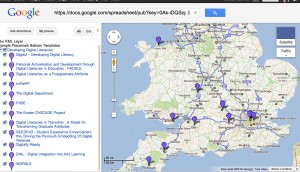
Map showing locations of DDL projects
The mindmap below gives an alternative view of the data entries for each project (if you click on the picture it will take you to a live version, NB the mind map will be open so you may find it easier to close nodes before exploring it in full).
The focus of the programme is more on the effective use of technology rather than as with other JISC funded work, the development of technology. On saying that, there are a couple of projects who are planning to develop some mobile applications and there are strong links between the work of the W2C project at MMU in relation the provision of mobile services, particularly with the SEEDPod project, University of Plymouth who have been working with MMU in conducting surveys of students uses of mobile devices. There are a number of approaches to mobile provision. The Developing Digital Literacy as a Post Graduate Attribute project is providing students with ipods to record and share their learning journeys, and to some extent leaving it to the students to find what works/doesn’t work for them. Whereas other projects (SEEDPod, InStePP) are developing more holistic, device and location agnostic approaches to provision of services/content.
So far we have 94 individual technologies and standards. The wordle below gives an overview.
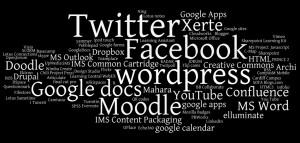
Wordle of technologies & Standards in DDL progamme (Jan '12)
This bubblegram gives another view of the range and instances of technologies and standards. Again if you click on the picture you’ll go to a larger, interactive version.
The projects area all blogging (you can access aggregated feeds here) and WordPress is top of our chart with 8 projects using it, the majority of these are also using institutionally hosted versions. What is also noticeable, is the (relatively) high instances of non- institutionally based services such a social networking sites – particularly twitter and Facebook. At the moment the main (and anticipated) use of both is for general project dissemination, however a number of projects are both to communicate with staff/students e.g. to get people involved in focus groups. The PADDLE project are planning to use existing facebook groups as collaboration/communication point with some of their focus groups.
Other external services such as drop-box (for document sharing), doodle for arranging meetings and a range of google apps (docs, calendar etc) are also being widely used. For the later there is a mix of institutional provision and more general use of, for example google docs for sharing project team related information. As with other programmes and the following a general sector wide trend, Moodle comes out as the most common VLE across the programme.
In terms of standards, the main focus was on packing formats with IMS CP, IMS CC and SCORM all getting one mention each. As we are still in early days, most projects haven’t got a clear idea of what format they will release any content in, however there was an overall interest in, and indeed knowledge of OER (i.e. the DIAL project is building on experiences from a previous UK OER project) and most projects expressed an desire to release any relevant content as OERs.
A number of projects (e.g. The Exeter Cascade Project, InStePP) are looking at greater integration of digital literacies into wider competency frameworks through for example making more explicit curriculum links to institutional graduate attributes; and also through working with other wider programme related stakeholders such as SCOUNL and ALT.
As mentioned earlier, projects are just coming to the end of their baselining work, and at this stage they are keen not to be prescriptive about the technologies they will be using, as they want to be as flexible as possible. Also, key to number of the projects is the exploration of the how, what, where and why of technology use (both hardware and software) of staff and students and then making appropriate interventions/recommendations for wider institutional policies.
When I repeat this exercise next year, I have a suspicion that there may be a subtle shift to more institutionally based services as more content will have been created and being used/shared within VLEs/repositories. As any changes to curriculum provision, and institutional policies, if not in place, will be fairly well scoped by then too. I am wondering if we will see, similar to the Curriculum Design programme, an increase in the use of Sharepoint for more formal documentation and a decrease in use of more informal sharing services such as drop box. At the moment there the project teams are using drop box primarily for the convenience of any time/where/device access.
One of the things I was curious about was if these projects would be more “literate” in their choices of technologies to use, and what would be the balance between use of institutionally based services and more general web based services. I don’t think I have an answer to the question, but I have seen a healthy sense of pragmatism displayed by all the projects in terms of their approaches.
I’ve had some really interesting discussions with projects (particularly Digitally Ready) around the definition of technology and what it was I really wanted to record i.e. everyday /commonplace technologies like email, calendars etc; was I interested in what the project team were using for project management or more what they were using for stakeholder engagement? In fact it’s all of the above – which probably goes some way to explaining the number of different technologies recorded to date. I feel it’s also worthwhile every now and again just stepping back and reflecting on how our expectations of peoples and projects use of technologies (JISC programme digital literacy perhaps?) have evolved. A few years ago, we’d be lucky if we got all projects to have a blog with more than 2 or 3 entries by the end of a programme – now, it’s one of the first things on a projects to do list, and most institutions provide some kind of hosted blogging service.
When we were developing PROD originally it was to record the tools, standards outputs and development processes of very technically focused projects. However as we’ve started to use it more widely across the JISC elearning programme, we’ve used it not just to record what projects are building, but the what, how and when of technologies projects are actually using. In the not so development focused projects such as DDL this is central. I think that this is starting to give us some real evidence of the diversity and commonality of approaches within and across programmes, and give us greater understanding of how actual use of technologies is being enabled and embedded both from the bottom up and top down.
As they move into the next phase of the programme it will be fascinating to see how the projects start to use the findings from their baselining and how that will impact on their next phase of development.
]]>I suspect for most people involved in the development and teaching of courses, it’s a combination of all of the above. So, how can you ensure your learning outcomes are really engaging with all your key stakeholders?
Creating meaningful discussions around developing learning outcomes with employers was the starting point for the CogenT project (funded through the JISC Life Long Learning and Workforce Development Programme). Last week I attended a workshop where the project demonstrated the online toolkit they have developed. Initially designed to help foster meaningful and creative dialogue during co-circular course developments with employers, as the tool has developed and others have started to use it, a range of uses and possibilities have emerged.
As well as fostering creative dialogue and common understanding, the team wanted to develop a way to evidence discussions for QA purposes which showed explicit mappings between the expert employer language and academic/pedagogic language and the eventual learning outcomes used in formal course documentation.
Early versions of the toolkit started with the inclusion of number of relevant (and available) frameworks and vocabularies for level descriptors, from which the team extracted and contextualised key verbs into a list view.
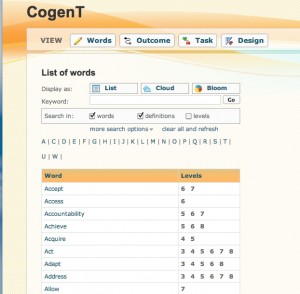
List view of Cogent toolkit
(Ongoing development hopes to include the import of competencies frameworks and the use of XCRI CAP.)
Early feedback found that the list view was a bit off-putting so the developers created a cloud view.

Cloud view of CongeT toolkit
and a Blooms view (based on Blooms Taxonomy).
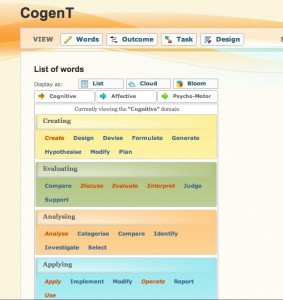
Blooms View of CogenT toolkit
By choosing verbs, the user is directed to set of recognised learning outcomes and can start to build and customize these for their own specific purpose.
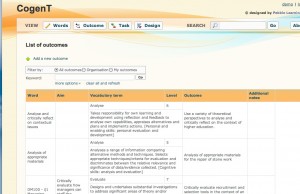
CogenT learning outcomes
As the tool uses standard frameworks, early user feedback started to highlight the potential for other uses for it such as: APEL; using it as part of HEAR reporting; using it with adult returners to education to help identify experience and skills; writing new learning outcomes and an almost natural progression to creating learning designs. Another really interesting use of the toolkit has been with learners. A case study at the University of Bedfordshire University has shown that students have found the toolkit very useful in helping them understand the differences and expectations of learning outcomes at different levels for example to paraphrase student feedback after using the tool ” I didn’t realise that evaluation at level 4 was different than evaluation at level 3″.
Unsurprisingly it was the learning design aspect that piqued my interest, and as the workshop progressed and we saw more examples of the toolkit in use, I could see it becoming another part of the the curriculum design tools and workflow jigsaw.
A number of the Design projects have revised curriculum documents now e.g. PALET and SRC, which clearly define the type of information needed to be inputted. The design workshops the Viewpoints project is running are proving to be very successful in getting people started on the course (re)design process (and like Co-genT use key verbs as discussion prompts).
So, for example I can see potential for course design teams after for taking part in a Viewpoints workshop then using the Co-genT tool to progress those outputs to specific learning outcomes (validated by the frameworks in the toolkit and/or ones they wanted to add) and then completing institutional documentation. I could also see toolkit being used in conjunction with a pedagogic planning tool such as Phoebe and the LDSE.
The Design projects could also play a useful role in helping to populate the toolkit with any competency or other recognised frameworks they are using. There could also be potential for using the toolkit as part of the development of XCRI to include more teaching and learning related information, by helping to identify common education fields through surfacing commonly used and recognised level descriptors and competencies and the potential development of identifiers for them.
Although JISC funding is now at an end, the team are continuing to refine and develop the tool and are looking for feedback. You can find out more from the project website. Paul Bailey has also written an excellent summary of the workshop.
]]>[View the story “JISC Assembly: Realising Co-generaTive Benefits ” on Storify]
]]>

